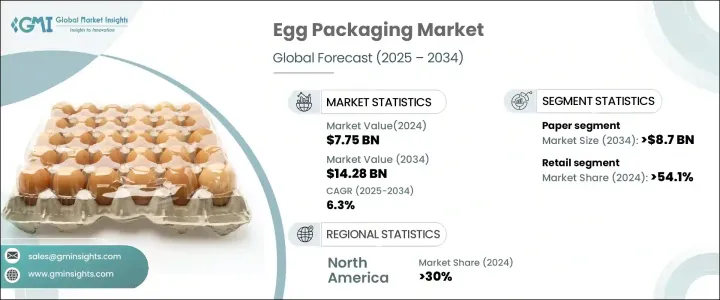
세계의 계란 포장 시장은 2024년에 77억 5,000만 달러에 이르렀으며, 2025-2034년 CAGR 6.3%로 안정된 성장률이 예측되고 있습니다.
이 시장 확대는 지속가능성에 대한 소비자 의식이 높아지고 환경 친화적인 패키징 솔루션에 대한 수요가 고조됨에 따라 커집니다. 기존의 포장재료가 환경에 미치는 영향을 인식하는 소비자 및 기업이 늘어남에 따라 제조업체는 지속 가능한 선택을 혁신할 필요가 있습니다. 플라스틱 포장에서 벗어나는 것은 가속화되고 섬유 기반과 종이 기반의 대체 소재가 중심입니다. 이러한 소재는 환경 친화적일 뿐만 아니라 세계적으로 관심이 높아지고 있는 이산화탄소 배출량을 줄이는 데에도 도움이 됩니다. 환경 규제가 강화되고 환경 친화적인 노력이 기세를 늘리는 가운데 계란 포장 시장은 강력한 성장을 이루고 있으며, 기업은 재활용 가능하고 생분해성이 있으며 지속 가능한 소재를 우선시하고 있습니다.

시장은 재료 유형에 따라 종이, 플라스틱 및 기타로 구분됩니다. 종이 부문이 주도권을 잡고, CAGR 7.8%로 성장할 전망이며, 2034년에는 87억 달러에 달할 것으로 예측되고 있습니다. 종이 기반 포장이 선호되는 것은 환경 친화적인 특성으로 인해 많은 기업과 소비자가 재활용 가능하고 생분해 가능한 소재로 기울어져 있습니다. 일반적으로 성형 섬유 및 재생지로 만들어진 종이제란팩은 환경을 배려할 뿐만 아니라 내구성도 우수하기 때문에 지속가능한 대체품을 찾고 있는 소비자나 소매업체에게 최적의 선택이 되고 있습니다. 이 종이팩은 가볍고 보호성이 뛰어나므로 계란의 안전한 운송과 보관이 가능하며 파손과 부패를 최소화하는 것이 소매업체에게 중요한 요소입니다.
| 시장 범위 | |
|---|---|
| 시작 연도 | 2024년 |
| 예측 연도 | 2025-2034년 |
| 시작 금액 | 77억 5,000만 달러 |
| 예측 금액 | 142억 8,000만 달러 |
| CAGR | 6.3% |
이 시장은 용도별로 소매용 포장과 운송용 포장으로 나뉩니다. 2024년에는 소매 부문이 시장을 독점했으며 시장 점유율의 54.1%를 차지했습니다. 소매용 계란 포장은 편리성, 브랜드화, 생산에서 판매까지 계란의 안전성 확보에 중점을 둡니다. 판지 및 크램쉘과 같은 소매용 패키징 솔루션은 명확한 라벨링, 장난 방지 기능, 매력적인 디자인을 제공하여 소비자 쇼핑 경험을 향상시키고 브랜드의 가시성과 판매 가능성을 높일 수 있도록 설계되었습니다. 이러한 패키징 솔루션은 기능적 보호를 제공할 뿐만 아니라 혼잡한 계란 시장에서 경쟁의 핵심 요소인 브랜드 차별화에도 기여합니다.
북미에서는 계란 포장 시장이 2024년에 30%의 점유율을 차지했으며, 미국이 지속 가능한 포장 솔루션으로의 전환을 주도했습니다. 환경 친화적인 생분해성 소재에 대한 소비자 수요가 높아지면서 성형 펄프 및 섬유 기반 계란 판지 채택이 증가하고 있습니다. 지속가능성이 제조업체와 소매업체 모두에게 점점 더 중요한 요소가 됨에 따라 북미 시장은 급속한 속도로 성장을 이어가고 환경 가치관에 따라 패키징 혁신에 투자하는 기업이 늘어날 것으로 예상됩니다.
환경 의식, 지속 가능한 선택을 요구하는 소비자의 기호, 패키징 기술의 선진성 등이 합쳐져, 계란 패키징 시장의 궤도는 분명히 상승 경향에 있습니다. 생분해성과 재활용 가능한 솔루션에 대한 지속적인 추세로 인해 업계 기업들은 진화하는 수요를 충족시키기 위해 혁신적인 패키징 옵션을 계속 개발할 것으로 예상됩니다.
The Global Egg Packaging Market reached USD 7.75 billion in 2024 and is projected to experience a steady growth rate of 6.3% CAGR from 2025 to 2034. This market expansion is largely driven by increasing consumer awareness of sustainability and the rising demand for eco-friendly packaging solutions. As more consumers and businesses recognize the environmental impact of traditional packaging materials, manufacturers are under increasing pressure to innovate with sustainable options. The transition away from plastic packaging is accelerating, with fiber-based and paper-based alternatives taking center stage. These materials not only offer eco-friendly properties but also help reduce carbon footprints, which is a growing concern worldwide. As environmental regulations tighten and green initiatives gain momentum, the egg packaging market is positioned for robust growth, with businesses prioritizing materials that are recyclable, biodegradable, and sustainable.

The market is segmented by material type into paper, plastic, and others. The paper segment is forecasted to lead the charge, growing at a CAGR of 7.8% and expected to reach USD 8.7 billion by 2034. The increasing preference for paper-based packaging stems from its eco-friendly properties, with many businesses and consumers leaning toward recyclable and biodegradable materials. Paper egg cartons, typically made from molded fiber or recycled paper, are not only environmentally responsible but also offer superior durability, making them a go-to choice for consumers and retailers looking for sustainable alternatives. The lightweight and protective nature of these cartons ensures the safe transportation and storage of eggs, a crucial factor for retailers concerned with minimizing breakage and spoilage.
| Market Scope | |
|---|---|
| Start Year | 2024 |
| Forecast Year | 2025-2034 |
| Start Value | $7.75 Billion |
| Forecast Value | $14.28 Billion |
| CAGR | 6.3% |
The market is further divided based on application into retail and transportation packaging. The retail segment dominated the market in 2024, accounting for 54.1% of the market share. Retail egg packaging focuses on convenience, branding, and ensuring the safety of eggs from production to point of sale. Retail packaging solutions, such as cartons and clamshells, are designed to enhance the consumer shopping experience by providing clear labeling, tamper-proof features, and attractive designs that improve brand visibility and sales potential. These packaging solutions not only offer functional protection but also contribute to brand differentiation, a key component of competition in the crowded egg market.
In North America, the egg packaging market held a 30% share in 2024, with the U.S. leading the charge in the shift toward sustainable packaging solutions. Driven by growing consumer demand for eco-friendly and biodegradable materials, the adoption of molded pulp and fiber-based egg cartons is on the rise. As sustainability becomes an increasingly important factor for both manufacturers and retailers, North America's market is expected to continue growing at a rapid pace, with more companies investing in packaging innovations that align with environmental values.
The egg packaging market's trajectory is clearly on an upward path, driven by a combination of environmental awareness, consumer preferences for sustainable options, and advancements in packaging technology. With the ongoing trend toward biodegradable and recyclable solutions, industry players are expected to continue developing innovative packaging options to meet evolving demands.